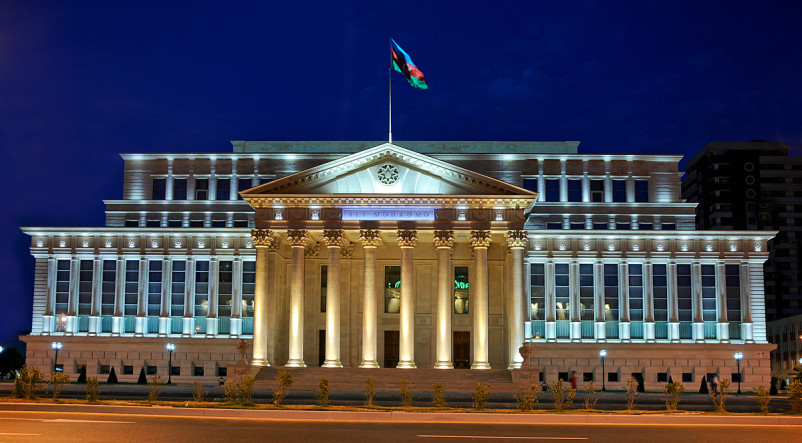About

The Supreme Court of the Republic of Azerbaijan is the highest judicial body with respect to civil, criminal and other (commercial and administrative) cases falling under the jurisdiction of the general and specialised courts of law. The Supreme Court administers justice as a court of cassation instance and provides clarifications on the issues related to the judicial practice. The Supreme Court is established in Baku, the capital of the Republic of Azerbaijan, and its jurisdiction extends to the entire territory of the Republic of Azerbaijan.
On November 14, 1918, the Azerbaijan Democratic Republic approved the "Regulation on the Judicial Chamber of Azerbaijan" in order to form an independent judiciary. With the adoption of the regulation, the Azerbaijan Court Chamber was established in Baku. The Judicial Chamber of Azerbaijan examines the activities of district courts, hears appeals from their decisions, abuses of office, property ownership rights, property guardianship, as well as performs notary duties.
In March 1920, the draft of the Statute of the Senate of Azerbaijan, which was intended to carry out the activities of the Supreme Court, was prepared and submitted to the Parliament of the Azerbaijan Democratic Republic for adoption. The Senate of Azerbaijan had to carry out law enforcement, administrative, cassation and judicial activities and functioned in a structure consisting of criminal, civil and administrative departments. However, the establishment of the Senate did not take place due to the occupation of the Azerbaijan Democratic Republic by the Soviet authorities.
After the occupation of the Azerbaijan Democratic Republic, at the session of the Central Executive Committee of the Azerbaijan SSR held on December 9, 1922, the "Regulation on the judicial structure in the Azerbaijan SSR" was adopted, on February 13, 1923, a decision was made to enforce the "Regulation on the judicial structure of the Azerbaijan SSR". In this decision, it was determined that the Supreme Court of Azerbaijan will start functioning from March 1, 1923.
In the period after the restoration of Azerbaijan's state independence, with the visionary policy of National Leader Heydar Aliyev, judicial and legal system reforms were gradually carried out. The legal status, place and role of the Supreme Court of the independent Republic of Azerbaijan are defined in the Constitution of the Republic of Azerbaijan adopted in 1995 under the initiative and leadership of the National Leader Heydar Aliyev. The determination of the Supreme Court of the Republic of Azerbaijan as the highest judicial body in Article 131 of the Constitution stems from its high legal status.
The composition of the Supreme Court includes the chief justice of the Supreme Court, his deputy, chairmen of the chambers and judges. The number of Supreme Court judges is determined at 41 seats. According to part 2 of Article 131 of the Constitution of the Republic of Azerbaijan, judges of the Supreme Court of the Republic of Azerbaijan are appointed by the Milli Majlis of the Republic of Azerbaijan upon submission by the President of the Republic of Azerbaijan. The chief justice, deputy chief justice and chairmen of the chambers are appointed by the President of the Republic of Azerbaijan among the judges of the Supreme Court.
The Supreme Court consists of the Plenum and cassation chambers. The Supreme Court has Civil, Criminal, Administrative and Commercial chambers. The Scientific Advisory Council operates under the Supreme Court in order to discuss the problems encountered in judicial practice, provide scientific advice on improving the legislation and support the preparation of proposals for the development of the law.
The Supreme Court forms a uniform judicial practice on the application of the law through the decisions of the judicial chambers and the Plenum of the Supreme Court on the cases it hears, as well as the explanations given by the Plenum on the judicial practice. As a result of the generalization of judicial practice, when systematic issues in the application of substantive and procedural legal norms are identified by the courts, the Plenum of the Supreme Court considers the issue and adopts a decision providing an appropriate explanation in order to avoid such shortcomings.
After the decision of the Plenum of the Supreme Court on the systemic flaws in the application of material and procedural legal norms by the courts, monitoring of the activity of the courts is conducted in the area where defects are identified. Monitoring is carried out for at least 1 year. The procedure for the conduct of monitoring is determined by the Judicial-Legal Council based on the proposals of the Supreme Court. The results of monitoring are taken into account during the evaluation of judges' activity by the Judicial-Legal Council.

